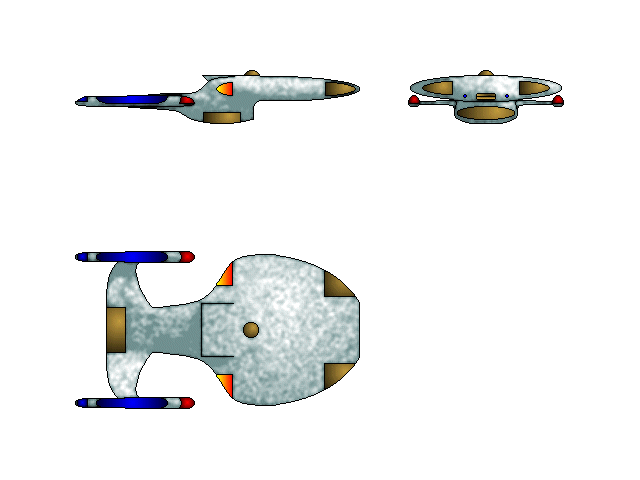

Shenandoah class
Inscription on commissioning plaque:
"It is easier to stay out than to get out."
General Specifications:-- Mark Twain
Armaments: Eight phaser cannon of classified output coupled to 6 phased arrays (see vessel description); Four quantum torpedo launchers of classified capability; one squadron of fighters; one squadron of semi-autonomous remotely piloted expendable vehicles (SARPEVs).
Type: Carrier/Exploration Cruiser
Status: Three in service, six under construction. More to be constructed as required.
About Ship: Commissioned too late to participate in the first phase of the Dominion war, the Shenandoah class vessel is being introduced as a replacement for the many medium-sized vessels lost to attrition. The Shenandoah implements as much advanced design philosophy and new technology as possible in a single spaceframe. A subsidiary design objective is to ensure this class is not rendered obsolete by an outbreak of peace.
The Shenandoah incorporates several new technologies into the hull. It has ablative armor and shields with automatic frequency rotation. The hull itself incorporates holographic projectors, providing a chameleon-like ability to adjust hull reflectivity and emissivity. This gives a fair imitation of cloaking without massive power consumption. This makes the Shenandoah extremely difficult to detect, making a positive weapons lock-on nearly impossible. It does not, however, confer true cloaking ability. The hull is devoid of markings which could help an enemy determine weak spots. The holographic hull surface actively displays desired hull markings such as registry numbers, vessel name or distinctive insignia.
The hull incorporates six phased arrays. These arrays are integrated networks of emitters and sensors imbedded directly within the hull matrix itself. Each array includes sensors, phasers, navigational deflectors, and tractor beams. Each array can take a significant amount of damage before performance is noticeably diminished. (The Borg aren't the only ones who can assimilate new ideas!) [Editor's note: I did this one just before I figured out the "Multifunction Phased Array" of the first VLV report.]
An added benefit of multiple phased arrays is a profound increase in sensor acuity and range. The sensor receptors provide the ability to precisely target an object 10 centimeters in diameter at a distance of just under 4 astronomical units.
A dual M/ARA arrangement supplies power, supplemented by a battery of quantum flywheels. The flywheels store several hours' worth of M/ARA output for emergency use, and are being considered as an upgrade to replace the standard emergency battery back-ups currently in use.
In addition to a standard complement of auxiliary vehicles, the Shenandoah class carries one squadron of fighters (12 light fighters or 8 heavies), and one squadron (25 units) of Semi-Autonomous Remotely Piloted Expendable Vehicles (SARPEVs, Mark II model). In peacetime, the fighter squadron is reduced to half strength, and is supplemented by from two to five additional auxiliary vehicles. There is enough additional space to accommodate two of the largest type of runabout in current use.
The Shenandoah class is economically converted to peacetime purposes. All interior fixtures (quarters, M/ARA, bridge, etc.) are designed as standardized quick-connect/disconnect modular assemblies. This differs from the current trend to design starships with removable "pie slices," but allows more latitude in starship configuration. Either engineering section can be removed and converted to family quarters and recreational facilities (not both simultaneously, however). Half the armaments can also be removed to provide space for laboratories, additional quarters, etc.
Return to "Ships Starfleet Never Built."
Return to the Starship Catalogue.